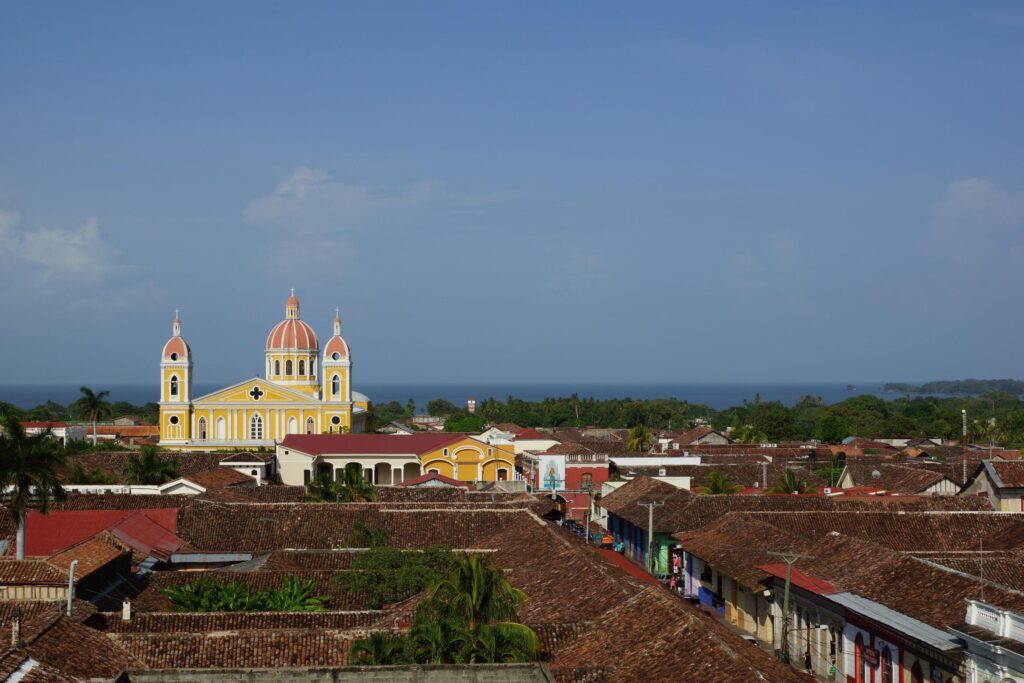Nicknamed „the Great Sultan“ in reference to its Moorish namesake across the Atlantic, Granada is Nicaragua‘s oldest colonial city. Founded in 1524 by Francisco Hernandez de Cordoba, it stands at the foot of Volcan Mombach on the northwestern shore of Lago di Nicaragua.
After leaving behind the guard with his rifle at the hotel, we are heading for the airport, clear immigration and take-off towards Nicaragua. After a short one hour flight we land in in Managua. Ground handling is very efficient, fuel here in no time but unfortunately there is no driver waiting for us. We take a local cab and drive the 45 minutes to Granada, the old colonial town, check in at the „Hotel con Corazon“, have a quick lunch at a local restaurants (a hamburger here is less then 80 cents) and do a 2 hour city tour with a horse carriage.
With access to the Caribbean Sea via the lake and the Rio San Juan, Granada soon became a rich and important trade center and remained so into the 19th century. This sam Caribbean passage made Granada an easy target for English and French buccaneers, who sacked the city three times between its founding and 1685. Conservative Granada was ever-locked in bitter rivalry with liberal Leon, which erupted into full-blown civil war in the 1850s. To gain upper hand, the Leonese contracted filibuster William Walker, who conquered Granada and ruled from there. Fleeing in 1856, he had the city torched, leaving only the infamous placard, „Here was Granada“. In more recent times, an expensive restoration program has given a new glow to its bright colonial charms.
We enjoy the city tour even though it is very hot and humid. We run into a funeral procession and catch up with it again at the impressive cemetery. The horse carriage drops us off at a boat pier and we visit „Las Isletas“. This group of 350 diminutive islands were formed 10‘000 years ago by an errupting Volcan Mombacho. Divided by narrow channels, they are memorably scenic and easily reached by motorboat. Many are inhabited (by traditional fishing families and now by Nicaragua‘s superwealthy), and some have hotels and restaurants (where we stop for a beer). There‘s a proliferation of birdlife throughout , with egrets, herons and cranes particularly numerous around sunrise and sunset. And we see a few of them.
Castillo de San Pablo, a small fort builit in 1784 to guard against British incursions and the Isla de Monos (Monkey Islands) whose residents come quite close to the passing boats, are the other attractions on the cruise.
We decide to have dinner in one of the best restaurants in town. The local fish is excellent, costing CHF 15.– and one would easily feed the three of us. But we have one each anyway; especially since it is the best fish we ever had!
The Pacific coast of Nicaragua was settled as a Spanish colony from Panama in the early 16th century. Independence from Spain was declared in 1821 and the country became an independent republic in 1838. Britain occupied the Caribbean Coast in the first half of the 19th century, but gradually ceded control of the region in subsequent decades. In the early 1900s, the US started to get involved in Nicaragua sending in Marines twice. In 1933 they were heading home after handing over military power to the US-trained Guardia Nacional, led by Anastasio Somoza. Over the next 20 years, he ruled as a notorious dictator amassing huge personal wealth by corrupt means (the Somoza landholdings attained were the size of El Salvador. Of course, the majority of Nicaraguans remained entrenched in poverty. Violent opposition to governmental manipulation and corruption spread to all classes by 1978 and resulted in a short-lived civil war that brought the Marxist Sandinista guerrillas to power in 1979. Nicaraguan aid to leftist rebels in El Salvador caused the US to sponsor anti-Sandinista contra guerrillas through much of the 1980s. Free elections in 1990, 1996 and 2001, saw the Sandinistas defeated but voting in 2006 and 2011 announced the return of former Sandinista President Daniel Ortega.
Nicaragua, the poorest country in Central America has widespread underemployment and poverty. But it is also one of the safest countries in the region. We never saw that many guns and armed guards as before in i. e. Guatemala and El Salvador. The Sandinista seem to deal very effectively with this problem.
